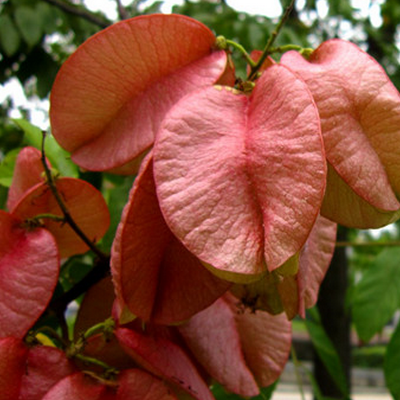Can the fruit of thick plum cuttage propagation be eaten?
Thick plum, this is known to many people, but also a lot of people in breeding, this thick plum blooming flowers and plum flowers are also a bit like, thick plum cutting propagation method is what? Can the fruit of thick plum be eaten:

The method of cutting propagation of thick plum:
1. Cuttage seedling
Thick plum is easy to take root in cuttage propagation, and hardwood cuttings are usually used instead of tender wood cuttings. This is because the twigs have strict requirements on temperature and humidity, and the survival rate is not very high.
2. Collect cuttings
Thick plum mother strips with strong growth can be selected as cuttings in autumn.
3. Storage cuttings
Cut the collected cuttings into equal-length stems, tie them into a handful and put them in the cellar and bury them with sand.
4. Cuttage
Remove the cuttings from the cellar, soak them in clean water for two to three days, and then irrigate the cuttings upright on the seedbed, so that the cuttings are closely connected with the soil, so that the cuttings can take root and survive as soon as possible.
5. Cutting management
Generally speaking, cuttings will gradually grow roots in 20 days. During this period, it is necessary to strengthen water management, keep the seedling bed moist, and prevent cuttings from dying because of water loss.
Can the fruit of thick plum be eaten:
Thick plums can be eaten raw.
Nutrition: thick plum fruit contains a lot of protein, roughly the same as apples, as well as organic acids and minerals. In addition to being able to eat raw, it is mainly used to process fruit juices, fruit wine and other products. The seeds of thick plums can also be used to extract industrial oil. Leaves can be used as medicine, to relieve cough, and to kill insects. The fruit is sweet and astringent, which can stop diarrhea and replenish the spleen.
This is the end of the introduction to the cutting propagation method of thick plum, the fruit of this thick plum is edible.
The main value of the Propagation method of thick Plum
Thick plum is a deciduous tree of Rosaceae, with long and beautiful inflorescences that can be planted alone, in clusters, in groups, and in pieces. What are the breeding methods of thick plums? What is the value? Let's take a look next.
1. A complete set of propagation methods of thick plums
1. Sowing and propagation of thick plum
Seed harvest: the seed harvest time is about the middle and last ten days of August in Liaoning area. When the fruit turns black, it can be harvested, soaked in water after harvest, the outer seed coat and pulp are removed by hand rubbing, the seeds are washed with clean water and thoroughly dried in a cool and ventilated place, so as to prevent the seeds from heating, mildew and rot and reduce their vitality.
Seed treatment: the seeds were stored in a cellar of 0-5 ℃. Late autumn choose dry terrain, good drainage, leeward to the sun to dig a pit, pit depth 1.5 meters anti-bottom 15 cm gravel or coarse sand, insert a bunch of grass handle in the middle of the pit in order to ventilation. The pit length and width depends on the number of seeds. Soak the seeds in 40 ℃ warm water for 2 days before storage, then mix the seeds with wet sand at 1:3, place them in the pit until they are 20 cm above the ground, and then backfill 10 cm above the ground. Dig drains around.
Sowing: at the beginning of April of the following spring, the seeds are raised from the pit and placed in a cool place to accelerate germination. When there are 1 stroke 3 seeds exposed, they can be sown. It is better to choose sandy loam with flat terrain, convenient drainage and irrigation, deep soil and loose soil. Sufficient base fertilizer should be applied every 667 meters before sowing. 50kg is appropriate, careful soil preparation for ridges, ridge surface should be flat, and sufficient bottom water should be irrigated. When the water seeps through, the soil dries a little, then pick up the ditch and evenly remove the seeds, with the sowing rate of every 667 square meters. 5 kilograms is suitable. Cover the soil after sowing, the thickness of the cover is 1.5 cm, after the cover is slightly suppressed, and the ridge surface should be kept moist in the future.
2. Cuttage propagation of thick plum.
Thick plum cuttings are easy to take root, and hardwood cuttings are generally used instead of softwood cuttings, because tender wood cuttings have strict requirements on environmental conditions, especially temperature and humidity, and the survival rate of transplanting is not as high as that of hardwood cuttings.
Collection of cuttings. In autumn, thick plum mother strips with strong growth and about 1 cm thick were selected as cuttings.
Storage of cuttings. After picking cuttings, cut the cuttings into cuttings 15 to 20 centimeters long, tie up 100 cuttings into a handful, and put them into the cellar and bury them with sand. The cuttings were cut in the following spring. The cuttings were taken out from the cellar and soaked in clean water for 2 days, then the cuttings were cut upright according to the plant spacing of 15 cm and the row spacing of 25 cm on the whole seedling bed, and then irrigated after cutting to make the cuttings closely connected with the soil and promote rooting and survival.
Second, the main value of thick plum
Ornamental value: thick plum young leaves bright green, old leaves purple-red, matched with other tree species, red and green match each other. In gardens and scenic spots, it can be planted alone, in clusters, in groups, or in pieces, or into large color hedges, and large flower bed patterns, and can also be used as secondary street trees on urban roads and landscape trees for greening in residential areas. It is also suitable for lawn, corner, fork road, hillside, riverside, stone side, courtyard, front of building, gate square and so on.
Nutritional value: the protein content of thick plum fruit is similar to that of apple, with 6.4% sugar and minerals and organic acids. In addition to raw food, it is mainly used for processing fruit juices, jams, fruit wine and other products. Thick plum seeds contain 38.79% oil, which can be used to extract industrial oil; leaves are used as medicine to relieve cough. Leaves contain volatile oil, which has insecticidal effect. The concentration of 1RV 8000LV 1RU 10000 could decrease the enzyme activity of worms and kill them on the surface. The fruit is sweet and astringent, which can stop diarrhea and replenish the spleen.
The above is the introduction of thick plum breeding methods and the main value of thick plum. I hope it will be helpful for everyone to breed thick plum. I also want to know other thick plum knowledge and continue to pay attention to us.
The function of how to reproduce thick plum
Thick plum is a deciduous tree, up to 15 meters high, thick plum flowers, fruits have a certain ornamental value, that thick plum how to breed? Next, let's take a look at the role of Chong Li.
How do thick plums reproduce?
Thick plums are usually propagated by sowing or cutting. The survival rate of cutting propagation is higher, sowing is suitable for large-scale propagation, and the harvested seeds can be stored.
1. Sowing and raising seedlings
The seeds of thick plums are harvested in about the middle to late August, when the fruit turns black. Soak in water after harvest, rub off the outer seed coat and pulp, wash it clean and put it in a cool and ventilated place.
Thick plum seeds can be stored in 0-5 ℃ cellar and begin to sprout in the shade at the beginning of April. Thick plum seeds should be fertilized and watered before sowing. Thick plum is suitable for growing in loose sandy soil.
The thick plum seedlings can all come out 10-15 days after sowing, and when the seedling height reaches 5 cm, the seedlings will grow for the first time to get weak and stay strong. The seedling can be fixed when the height of the seedling reaches 10-15 cm.
2. Cuttage seedling
Thick plum cuttings are easy to take root, and hardwood cuttings are generally used, and the survival rate of tender wood cuttings is low. In autumn, thick plum mother strips with strong growth and development of about one centimeter were selected and cut into small segments 15-20 centimeters long as cuttings, which were buried in the cellar with sand.
In spring, the cuttings were soaked in clean water for 2-3 days, and then irrigated after cutting, so that the cuttings were closely connected with the soil and promoted rooting and survival. Water management must be strengthened before rooting, and the bed must be kept moist to avoid water loss and death of plants.
The function of thick plum
1. Ornamental function
There are hanging branches, flowers and leaves, large flowers, small flowers, double, yellow fruit and red fruit and other varieties, fruit can attract birds, courtyard trees. The long face of the inflorescence is beautiful, the autumn leaves turn red and the fruit is bright black when it is ripe. It is a kind of ornamental tree with strong cold tolerance. In gardens and scenic spots, it can be planted alone, in clusters, in groups, and in pieces, often as scenic trees.
2. Nutritional value
The protein content of the fruit is roughly similar to that of apples, with 6.4% sugar and minerals and organic acids. In addition to raw food, it is mainly used for processing fruit juices, jams, fruit wine and other products. Thick plum seeds contain 38.79% oil, which can be used to extract industrial oil; leaves are used as medicine to relieve cough. Leaves contain volatile oil, which has insecticidal effect.
- Prev

How much is the cutting propagation method of Koelreuteria paniculata
Artemisia angustifolia, which is favored by many people, is generally not potted, it is too big, what is the method of cuttage propagation? How much is the oak tree: Koelreuteria cuttings propagation method: collect cuttings, the oak tree can collect the trunk to make seed strips after the fallen leaves in autumn.
- Next

When can water lilies bloom and be raised in full water?
Water lily, this kind of plant is favored by many people. This water lily is so likeable. When will this water lily blossom? Can water lilies be raised in full water: when water lilies bloom: the leaves of water lilies are round or nearly round, or oval, while some varieties are lanceolate or arrow-shaped, with entire leaves.
Related
- Fuxing push coffee new agricultural production and marketing class: lack of small-scale processing plants
- Jujube rice field leisure farm deep ploughing Yilan for five years to create a space for organic food and play
- Nongyu Farm-A trial of organic papaya for brave women with advanced technology
- Four points for attention in the prevention and control of diseases and insect pests of edible fungi
- How to add nutrient solution to Edible Fungi
- Is there any good way to control edible fungus mites?
- Open Inoculation Technology of Edible Fungi
- Is there any clever way to use fertilizer for edible fungus in winter?
- What agents are used to kill the pathogens of edible fungi in the mushroom shed?
- Rapid drying of Edible Fungi

